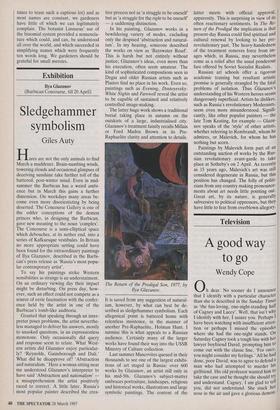Exhibition
Ilya Glazunov (Barbican Concourse, till 20 April)
Sledgehammer symbolism
Giles Auty
Hares are not the only animals to find March a maddener. Brain-numbing winds, towering clouds and occasional glimpses of deceiving sunshine take further toll of the battered, post-winter mind. Even in mid- summer the Barbican has a weird ambi- ence but in March this gains a further dimension. On weekdays many areas be- come even more disorientating by being deserted. The Concourse Gallery is one of the odder conceptions of the demon princes who, in designing the Barbican, gave new meaning to the noun 'complex'. The Concourse is a semi-elliptical space which debouches, at its nether end, into a series of Kafkaesque vestibules. In Britain no more appropriate setting could have been found for the extraordinary paintings of Ilya Glazunov, described in the Barbi- can's press release as 'Russia's most popu- lar contemporary artist'.
To say his paintings strike Western sensibilities as strange is an understatment. On an ordinary viewing day their impact might be disturbing. On press day, how- ever, such an effect could not compete as a source of eerie fascination with the confer- ence held by the artist in one of the Barbican's tomb-like auditoria.
Granted that speaking through an inter- preter poses problems, the artist neverthe- less managed to deliver his answers, mostly to unasked questions, in an expressionless monotone. Only occasionally did query and response seem to relate. What West- ern artists did Glazunov enjoy particular- ly? 'Reynolds, Gainsborough and Dali.' What did he disapprove of? 'Abstraction and naturalism.' Here a woman sitting near me understood Glazunov's interpreter to have said 'Abstraction and nationalism' — a misapprehension the artist positively raced to correct. A little later, Russia's most popular painter described the crea- tive process not as 'a struggle to be oneself' but as 'a struggle for the right to be oneself — a saddening distinction.
In his painting, Glazunov works in a bewildering variety of modes, excluding only the despised 'abstraction and natural- ism'. In my hearing, someone described the works on view as 'Bayswater Road'. This is harsh but not entirely without justice; Glazunov's ideas, even more than his execution, often seem amateur. The kind of sophisticated compositions seen in Degas and older Russian artists such as Plastov find no place in his work. Even so, paintings such as Evening, Dostoyevsky: White Nights and Farewell reveal the artist to be capable of sustained and relatively controlled image-making.
The latter huge work shows a traditional burial taking place in autumn on the outskirts of a large, industrialised city. Glazunov's treatment faintly recalls Millais or Ford Madox Brown in its Pre- Raphaelite clarity and attention to details.
The Return of the Prodigal Son, 1977, by Ilya Glazunov.
It is saved from any suggestion of natural- ism, however, by what can best be de- scribed as sledgehammer symbolism. Each allegorical point is battered home with relentless insistence, in the manner of another Pre-Raphaelite, Holman Hunt. I surmise this is what appeals to a Russian audience. Certainly many of the larger works have found their way into the USSR Ministry of Culture collection.
Last summer Muscovites queued in their thousands to see one of the largest exhibi- tions of art staged in Russia: over 600 works by Glazunov, an artist still only in his mid-50s. Glazunov's subject-matter embraces portraiture, landscapes, religious and historical works, illustrations and large symbolic paintings. The content of the latter meets with official approval, apparently. This is surprising in view of its often reactionary sentiments. In The Re- turn of the Prodigal the implication is that present-day Russia could find spiritual and cultural renewal by looking to her pre- revolutionary past. The heavy-handedness of the treatment removes force from im- ages which, in Russia, may nevertheless come as a relief after the usual ponderous fare offered by Soviet Socialist Realists. Russian art schools offer a rigorous academic training but resultant artistic promise is generally strangled by the fatal problems of isolation. Thus Glazunov's understanding of his Western heroes seems dangerously superficial. Artists he dislikes, such as Russia's revolutionary Modernists, seem even more misunderstood. Signifi- cantly, like other populist painters — the late Tom Keating, for example — Glazu- nov speaks of the 'style' of other artists, whether referring to Rembrandt, whom he admires, or Malevich, for whom he has nothing but scorn.
Paintings by Malevich form part of an outstanding auction of works by the Rus- sian revolutionary avant-garde to take place at Sotheby's on 2 April. As recently as 15 years ago, Malevich's art was still considered degenerate in Russia, but this position has changed. The folly of politi- cians from any country making pronounce- ments about art needs little pointing out. Great art, by its nature, is generally subversive to political oppressors, but they have little to fear from overblown allegory.


















































 Previous page
Previous page